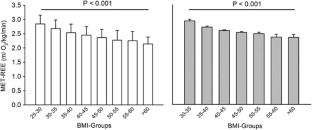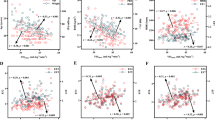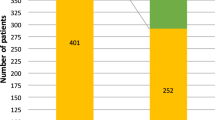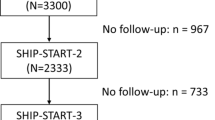Correction factors for the calculation of metabolic equivalents (MET) in overweight to extremely obese subjects
The metabolic equivalent (MET) is a construct that is commonly used to quantify physical activity as well as exercise performance. ‘One MET’ is equal to a resting oxygen uptake of 3.5 ml O2 kg −1 min − 1 . However, this assumption is unlikely valid in obese subjects. The aim of our study was to quantify the difference between calculated and measured METs in overweight to severely obese subjects and to provide body mass index (BMI)-specific MET correction factors.
Subjects/Methods:
Resting oxygen uptake (VO2-REE) was measured in 1331 patients with a BMI >25 kg m −2 (72.0% women; age: 42.5±13.0 years; BMI: 42.5±7.0 kg m − 2 ) by indirect calorimetry and MET-REE, that is, VO2-REE related to body weight was calculated. Six hundred and fifty-two subjects (70.9% women) additionally underwent a bicycle cardiopulmonary exercise test for measurement of maximal MET (MET peak).
Results:
Conclusions:
Data indicate that the commonly used 1-MET value of 3.5 ml O2 kg − 1 min − 1 largely overestimates values in overweight to severely obese subjects. Our correction factors can help to reduce this systematic error and thus appear to be valuable for clinical practice as well as research studies.
This is a preview of subscription content, access via your institution
Access options
Subscribe to this journal
Receive 12 print issues and online access
265,23 € per year
only 22,10 € per issue
Buy this article
- Purchase on SpringerLink
- Instant access to full article PDF
Prices may be subject to local taxes which are calculated during checkout


Feasibility of predicting maximal oxygen uptake by using the efficiency factor in healthy men
Article Open access 05 October 2023

Edmonton Obesity Staging System: an improvement by cardiopulmonary exercise testing
Article 14 May 2021

Body surface scan anthropometrics are related to cardiorespiratory fitness in the general population
Article Open access 23 December 2022
References
- Kimm SY, Glynn NW, Obarzanek E, Kriska AM, Daniels SR, Barton BA et al. Relation between the changes in physical activity and body-mass index during adolescence: a multicentre longitudinal study. Lancet 2005; 366: 301–307. ArticleGoogle Scholar
- Bond DS, Jakicic JM, Vithiananthan S, Thomas JG, Leahey TM, Sax HC et al. Objective quantification of physical activity in bariatric surgery candidates and normal-weight controls. Surg Obes Relat Dis 2010; 6: 72–78. ArticleGoogle Scholar
- Levine JA, Lanningham-Foster LM, McCrady SK, Krizan AC, Olson LR, Kane PH et al. Interindividual variation in posture allocation: possible role in human obesity. Science 2005; 307: 584–586. ArticleCASGoogle Scholar
- Ekelund U, Aman J, Yngve A, Renman C, Westerterp K, Sjöström M . Physical activity but not energy expenditure is reduced in obese adolescents: a case-control study. Am J Clin Nutr 2002; 76: 935–941. ArticleCASGoogle Scholar
- Hulens M, Vansant G, Claessens AL, Lysens R, Muls E . Predictors of 6-minute walk test results in lean, obese and morbidly obese women. Scand J Med Sci Sports 2003; 13: 98–105. ArticleCASGoogle Scholar
- Lee DC, Sui X, Artero EG, Lee IM, Church TS, McAuley PA et al. Long-term effects of changes in cardiorespiratory fitness and body mass index on all-cause and cardiovascular disease mortality in men: the Aerobics Center Longitudinal Study. Circulation 2011; 124: 2483–2490. ArticleGoogle Scholar
- Lee DC, Sui X, Ortega FB, Kim YS, Church TS, Winett RA et al. Comparisons of leisure-time physical activity and cardiorespiratory fitness as predictors of all-cause mortality in men and women. Br J Sports Med 2011; 45: 504–510. ArticleGoogle Scholar
- Kokkinos P, Sheriff H, Kheirbek R . Physical inactivity and mortality risk. Cardiol Res Pract 2011; 2011: 924–945. ArticleGoogle Scholar
- Irwin M L, Mayer-Davis EJ, Addy CL, Pate RR, Durstine JL, Stolarczyk LM et al. Moderate-intensity physical activity and fasting insulin levels in women: the Cross-Cultural Activity Participation Study. Diabetes Care 2000; 23: 449–454. ArticleCASGoogle Scholar
- Hee PH, Macfarlane DJ, Lam TH, Stewart SM . Validity of the International Physical Activity Questionnaire Short Form (IPAQ-SF): a systematic review. Int J Behav Nutr Phys Act 2011; 8: 115. ArticleGoogle Scholar
- Unick JL, Bond DS, Jakicic JM, Vithiananthan S, Ryder BA, Roye GD et al. Comparison of two objective monitors for assessing physical activity and sedentary behaviors in bariatric surgery patients. Obes Surg 2012; 22: 347–352. ArticleGoogle Scholar
- Byrne NM, Hills AP, Hunter GR, Weinsier RL, Schutz Y . Metabolic equivalent: one size does not fit all. J Appl Physiol 2005; 99: 1112–1119. ArticleGoogle Scholar
- Task Force for Preoperative Cardiac Risk Assessment and Perioperative Cardiac Management in Non-cardiac Surgery; European Society of Cardiology (ESC) Poldermans D, Task Force for Preoperative Cardiac Risk Assessment and Perioperative Cardiac Management in Non-cardiac Surgery; European Society of Cardiology (ESC) Bax JJ, Task Force for Preoperative Cardiac Risk Assessment and Perioperative Cardiac Management in Non-cardiac Surgery; European Society of Cardiology (ESC) Boersma E, Task Force for Preoperative Cardiac Risk Assessment and Perioperative Cardiac Management in Non-cardiac Surgery; European Society of Cardiology (ESC) De Hert S, Task Force for Preoperative Cardiac Risk Assessment and Perioperative Cardiac Management in Non-cardiac Surgery; European Society of Cardiology (ESC) Eeckhout E, Task Force for Preoperative Cardiac Risk Assessment and Perioperative Cardiac Management in Non-cardiac Surgery; European Society of Cardiology (ESC) Fowkes Get al. Task Force for Preoperative Cardiac Risk Assessment and Perioperative Cardiac Management in Non-cardiac Surgery; European Society of Cardiology (ESC) Guidelines for pre-operative cardiac risk assessment and perioperative cardiac management in non-cardiac surgery. Eur Heart J 2009; 30: 2769–2812. ArticleGoogle Scholar
- Bosy-Westphal A, Reinecke U, Schlörke T, Illner K, Kutzner D, Heller M et al. Effect of organ and tissue masses on resting energy expenditure in underweight, normal weight and obese adults. Int J Obes Relat Metab Disord 2004; 28: 72–79. ArticleCASGoogle Scholar
- Weir JB . New methods for calculating metabolic rate with special reference to protein metabolism. J Physiol 1949; 109: 1–9. ArticleGoogle Scholar
- Fletcher GF, Balady GJ, Amsterdam E, Chaitman B, Eckel R, Fleg J et al. Exercise standards for testing and training. Circulation 2001; 104: 1694–1740. ArticleCASGoogle Scholar
- Ainsworth BE, Haskell WL, Whitt MC, Irwin ML, Swartz AM, Strath SJ et al. Compendium of physical activities: an update of activity codes and MET intensities. Med Sci Sports Exerc 2000; 32: 498–516. ArticleGoogle Scholar
- Alvarez VP, Dixon JB, Strauss BJ, Laurie CP, Chaston TB, O'Brien PE . Single frequency bioelectrical impedance is a poor method for determining fat mass in moderately obese women. Obes Surg 2007; 17: 211–221. ArticleGoogle Scholar
- Panotopoulos G, Ruiz JC, Guy-Grand B, Basdevant A . Dual x-ray absorptiometry, bioelectrical impedance, and near infrared interactance in obese women. Med Sci Sports Exerc 2001; 33: 665–670. ArticleCASGoogle Scholar
- Müller M, Bosy-Westphal A, Klaus S, Kreymann G, Lührmann MP, Neuhäuser-Berthold M et al. World Health Organization equations have shortcomings for predicting resting energy expenditure in persons from a modern, affluent population: generation of a new reference standard from a retrospective analysis of a German database of resting energy expenditure. Am J Clin Nutr 2004; 80: 1379–1390. ArticleGoogle Scholar
Author information
Authors and Affiliations
- Department of Surgery, Cantonal Hospital, St Gallen, Switzerland B Wilms
- Exercise Physiology Lab, Institute of Human Movement Sciences, ETH Zurich, Zurich, Switzerland B Wilms
- eSwiss Medical and Surgical Center, St Gallen, Switzerland B Ernst, M Thurnheer & B Schultes
- Institute of Sport Science, University of Kiel, Kiel, Germany B Weisser
- B Wilms





